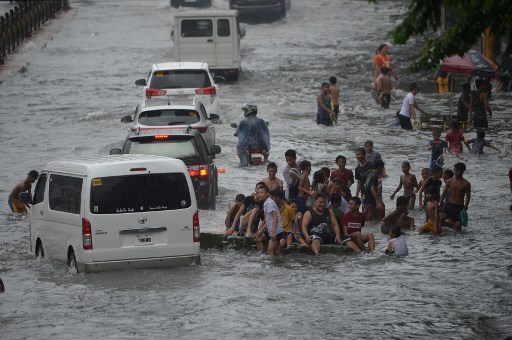
At least three people died and six were missing after a major storm caused widespread flooding in and around the Philippine capital on September 12, forcing schools, government offices and businesses to shut down. / AFP PHOTO / TED ALJIBE
MANILA, Philippines (AFP) — At least three people died and six were missing after a major storm caused widespread flooding in and around the Philippine capital on Tuesday, forcing schools, government offices and businesses to shut down.
The tropical depression, which left some people wading through chest-deep waters outside Manila, was the latest to hit the Southeast Asian archipelago, which endures about 20 such storms each year.
Most of the dead and missing were poor people forced to live in identified “danger zones” despite government warnings of the risks they face during storms.
“Our local authorities had continuously warned them that their place was really prone to landslides but they insisted on staying,” said civil defence officer Ronnie Mateo after the rain caused a landslide that fatally buried two teenage brothers just east of Manila.
A 12-year-old girl drowned in a rain-swollen river in a Manila suburb, city officials said.
The storm, locally codenamed “Maring”, hit the eastern town of Mauban before moving northwest across the main island of Luzon and passing just beside Manila, the government weather station said.
In Calamba City south of Manila a flash flood washed away a riverside shanty, leaving six inhabitants including a two-year-old missing.
“They were informal settlers, living beside a river. There was a flash flood and it washed out their two storey-house,” said Noriel Habana, head of the city’s disaster management office.
“In previous floodings, we had pre-emptive evacuation. It just so happened it was a flash flood and they had no time to react,” he told AFP.
Forecaster Renito Paciente said Maring, packing gusts of 100 kilometres (62 miles) per hour, was moving at just 15 kilometres per hour, worsening the flooding.
“Because it moves slowly, it can bring more rain over an area,” he told AFP.
Mark Timbal, spokesman for the National Disaster Risk Reduction and Management Council, said local governments had ordered the evacuation of residents from low-lying, coastal and landslide-prone areas.
He could not immediately give a total for those forced to flee.
The Philippine islands are often the first major land mass to be hit by storms that generate over the Pacific Ocean, bringing frequent death and misery.
In one of the worst recent incidents, 7,350 people were left dead or missing after super-typhoon Haiyan struck the central Philippines in November 2013.
© Agence France-Presse







